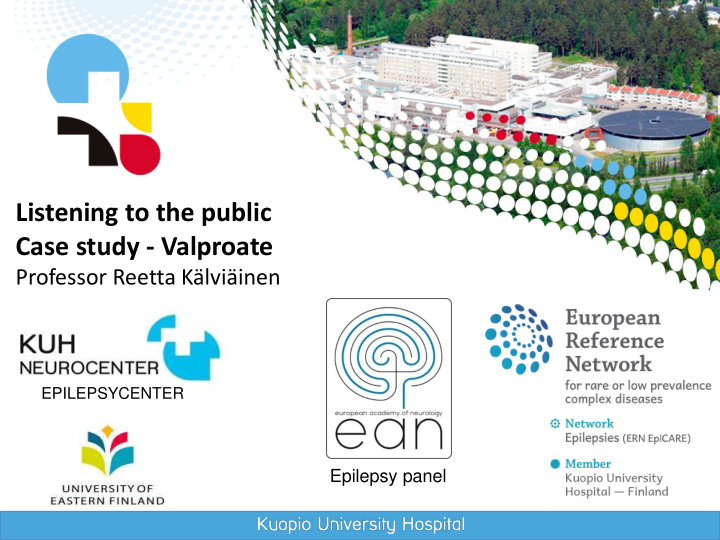



Listening to the public Case study - Valproate Professor Reetta Kälviäinen EEPILEPSYCENTER Epilepsy panel
Questions doctors had prior to the hearing • Similar as patients: – Will it contribute to the decision-making? Or post-hoc explanation of an already made decision? – Will it be confrontational, political? – A dialogue or series of stakeholders’ statements? • But also: – Will there be accusations ? Looking for responsible persons ? financial compensation ? – Will there be room for evidence based medicine or only for ’emotion based medicine’ ? – How can PRAC make sure that it gets a balanced view and patients with various situations are heard ? Also those girls and women who desperately need valproate for treatment of their epilepsy ?
Questions doctors had prior to the hearing • And also: – How we as the neurology community can take care that the voice that we want to give is heard ? • We should actively identify and counsel our female patients who might still be using valproate unnecessarily—eg, women with focal epilepsy for whom treatment alternatives that are at least as effective as valproate are available – we want to stop this unnecessary use of valproate due to increased teratogenicity • In some cases, valproate might be the only effective treatment. Therefore, valproate treatment still needs to be allowed for females in the rare instances when other options are ineffective or not tolerated. • Other alternative treatments carry also risks, some of which are unknown and some of which (depending on the dose) are nearly the same as with valproate, especially if substituing valproate leads to use of polytherapy
Questions doctors had prior to the hearing • And also: – Publicity that generates fear and anxiety without guidance may result in women stopping their treatment without support and increase risk of SUDEP
First EMA Public hearing September 2017
Experiences doctors had in the hearing • Similar as patients: – All participants could feel they could talk with equal credibility as others and all opinions were listened to, and different opinions could be confronted • But also: – Female patients using valproate, because nothing else helps, were not heard – Patients, who told their experiences, did not tell that several of them are still on valproate as it works best – Families with daughters needing valproate for severe epileptic encephalopathies were not heard therefore doctors needed to speak for these patients in order for VPA not be contraindicated in female patients
Experiences doctors had in the hearing • And also: • Much of the discussion dealt only about warning of pregnancy during valproate, however, many situations are very complex and this complexity and adequate information for fully informed decision between different treatment choices should have been discussed more
Measures by PRAC February 2018 9
Risk of major congenital malformations with different AED monotherapies compared with lamotrigine ≤325 mg/day p =0.0002 (Upper 95% CI: 23.64) Odds ratio (95% CI) p =0.0002 p =0.0002 p =0.1554 p =0.0196 p =0.923 p =0.0002 p =0.0002 p =0.2524 p =0.0463 p =0.0143 p =0.7282 p =0.7358 Odds ratio=1 AED dose (mg/day) AED, antiepileptic drug; CBZ, carbamazepine; CI, confidence interval; LEV, levetiracetam; LTG, lamotrigine; OXC, oxcarbazepine; PB, phenobarbital; PHT, phenytoin; Ref, reference; TPM, topiramate; VPA, valproate. Tomson T, et al. Lancet Neurol 2018;17:530–8.
Dose-dependent teratogenicity of valproate in mono- and polytherapy: An observational study. Tomson, Torbjorn; Battino, Dina; Bonizzoni, Erminio; Craig, John; Lindhout, Dick; Perucca, Emilio; Sabers, Anne; Thomas, Sanjeev; Vajda, Frank Neurology. 85(10):866-872, September 8, 2015. 2
Predicted malformation risk of topiramate drug dose for the 484 AED polytherapy exposed pregnancies NOT INVOLVING VALPROATE Antiepileptic drug combinations not involving valproate and the risk of fetal malformations, Vajda FJ, O'Brien TJ, Lander CM, Graham J, Eadie MJ. Epilepsia. 2016 Jul;57(7):1048-52.
Conclusions • The decision making surrounding valproate will remain complex • Women with epilepsy have to be treated very individually, especially if poorly controlled and wanting to become pregnant • Adequate information for fully informed decision • Information and decision making process needs to be documented • Polytherapy with and without VPA carry high-risks for the fetus (higher than VPA monotherapy !) • Uncontrolled seizures carry high-risk for the mother
Conclusions • Parents of children with fetal valproate syndrome express grief and anger at delays in recognition of the problem, delays in diagnosis, and inadequate support for those with lifelong disabilities. – the support, however, does not differ from other disabilities and should of course have been given and should be given regardless of the etiology or the causality • My personal impression is that more women now decide not to have children than before and we see this influence in the pregnancy registry data, where women tend to have similar seizure-control with less VPA-use – risk for increasing stigma related to epilepsy
Recommend
More recommend